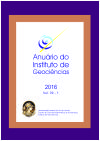Raninidae Crustaceans of the Maria Farinha Formation (Paleocene-Eocene), Pernambuco State, Brazil
DOI:
https://doi.org/10.11137//2016_3_32_40Keywords:
Maria Farinha Formation, Brachyura, Raninoides.Abstract
This work deals the systematic and paleobiologic studies of the crustaceans of Maria Farinha formation, belonging to the monophyletic group Raninidea. The species Raninoides fulgidus Rathbun, 1926 and R. lewisana Rathbun, 1926 are marine in muddy and sandy bottoms in quite waters below wave base. The sternum and the thoracic sternites morphology as well as the inflexion between abdomen and sternum attest burrowing characteristics. The raninids are well preserved, even nearly complete due to the ausence of scavengers and bottom-dwelling organisms, and a low-energy environmental conditions during the accumulation of these remains. The paleobiogeographic setting suggest that the dispersion pattern in this group is similar with the considered to the Paguridae, Calianassidae and Goneplacidae also recorded in Maria Farinha formation, to have originated at higher latitudes in North Atlantic to the central and south Atlantic and Tethys sea as well as to south latitudes by surface currents in the seaway east to west. The two species of raninoid are recorded in the Aldwell e Hoko River formations, Eocene of Washington state, United States of America, that coincide with their major diversity in cenozoic times, the deposition interval Maria Farinha reached Paleoceno-Eocene, as already mentioned in previous research.Downloads
Download data is not yet available.
Downloads
Published
2016-10-03
How to Cite
Távora, V. de A. (2016) “Raninidae Crustaceans of the Maria Farinha Formation (Paleocene-Eocene), Pernambuco State, Brazil”, Anuário do Instituto de Geociências. Rio de Janeiro, BR, 39(3), pp. 32–40. doi: 10.11137//2016_3_32_40.
Issue
Section
não definida
License
This journal is licensed under a Creative Commons — Attribution 4.0 International — CC BY 4.0, which permits use, distribution and reproduction in any medium, provided the original work is properly cited.















